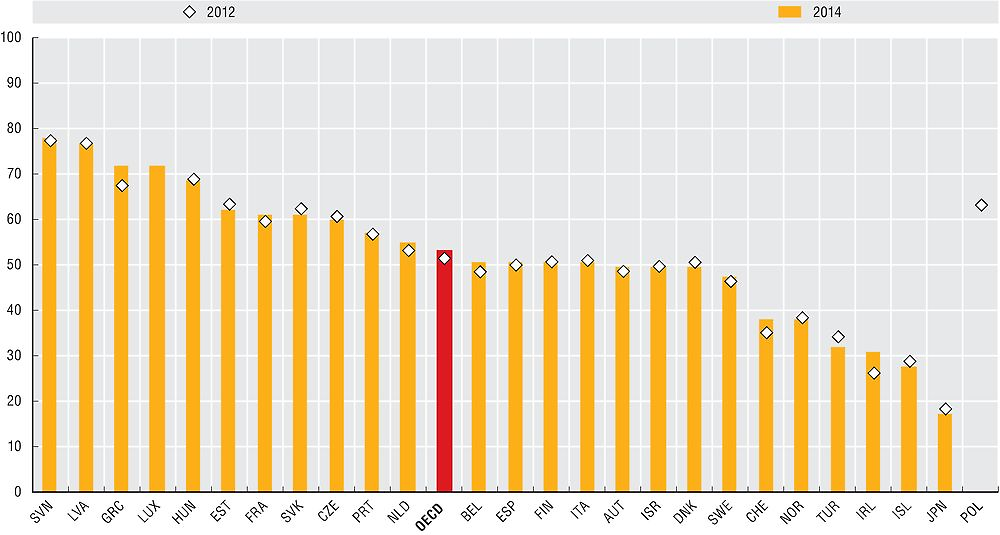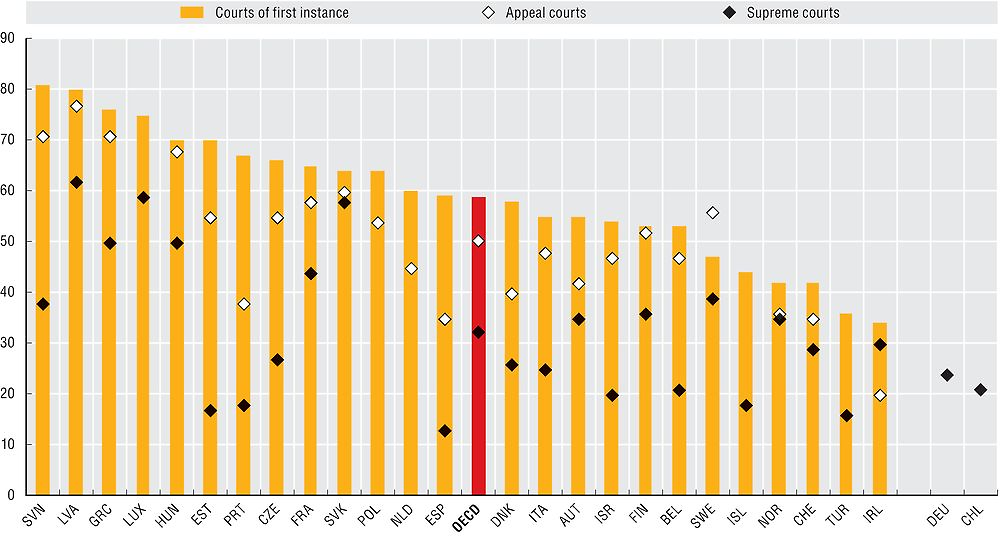Women in the judiciary
Ensuring gender balance in judicial leadership has been increasingly highlighted by OECD countries as a key governance issue related to fairness, transparency and the effective rule of law. Female judicial appointments, particularly at senior levels, can help shift gender stereotypes and increase women’s willingness to enforce their rights.
In terms of overall gender ratio for professional judges, available data reveal that gender parity has been reached and surpassed in most OECD countries, with women representing on average 53% of all judges in 2014, which is a 1% increase from 2012. In some cases, such as Switzerland and Ireland, the share of women has risen more steeply by 5% and 7% respectively. In the last decade, increasing efforts to establish gender-balanced appointment panels and to ensure a fair selection procedure of judges, the introduction of flexible work arrangements and greater promotion of women’s access to the legal profession have contributed to greater gender balance in the judiciary.
Gender representation varies between different levels of courts. Women occupy on average 59% of offices in first instance courts and 50% in appeal courts, but hold only 32% of judgeships in supreme courts. Furthermore, 77% of countries with available data have a majority of female judges in first instance courts, while this is only the case in 48% of countries in appeal courts. For supreme courts, the ratio drops dramatically to 15%. Stringent requirements for appointments seem to represent additional challenges for women in judicial leadership. In Commonwealth countries, for instance, the assumption that only top barristers can become top judges evidently limits the pool of candidates for senior appointments and particularly penalizes women who are most affected by challenges related to work-life balance when progressing in their legal career, and thus are most likely to abandon it.
Awareness of and responsiveness towards the barriers hindering women’s judicial careers has increased across OECD countries during the last decade. Several countries have adopted affirmative measures to ensure gender balance in the judiciary, including in senior positions. Following the example of other countries (e.g. Canada or the United Kingdom), Ireland is working towards establishing a judicial appointments commission which indicates among its goals the realization of gender balance. The Spanish general council of the judicial power approved the Plan of Equality in the Judicial Career in 2013, which aims to eliminate any form of gender discrimination in accessing and advancing within the judicial career, ensure professional development of women, better reconciliation of work and family life, and a higher participation of women in decision-making. Some OECD countries such as Denmark, Germany, Norway and the United Kingdom indicated that they had promoted gender-sensitive recruitment processes in 2014, including the adoption of measures such as gender - balanced selection committees and increasing diversity in the candidates’ pool.
The data presented is collected by the European Commission for the Efficiency of Justice (CEPEJ). Data refer to 2012 and 2014 and cover 25 OECD countries that are members of the Council of Europe. Details on the data can be found in the CEPEJ study 23 on “European Judicial Systems - Efficiency and Quality of Justice” (2014, 2016 editions).
Courts of first instance are where legal proceedings are begun or first heard; appeal courts review decisions issued by lower courts; supreme courts are the highest courts within the hierarchy of many legal jurisdictions and primarily function as appeal courts, reviewing decisions of lower courts and intermediate-level appeal courts.
Professional judges are those recruited, trained and remunerated to perform the function of a judge as a main occupation. This category includes professional judges from first instance, appeal and supreme courts.
The term gender-sensitive is used to highlight consideration of and responsiveness to the different needs and circumstances of individuals as affected by gender roles (i.e. gender-sensitive policies, courts, workplaces).
Affirmative measures indicate any policy favouring members of a disadvantaged group who suffer or have suffered from discrimination. In public life, affirmative measures often refer to specific requirements and processes (related to recruitment, promotion, appointment and election) supporting under-represented groups in various occupations and offices.
Further reading
OECD (2016), 2015 OECDRecommendation of the Council on Gender Equality in Public Life, OECD, Paris. https://doi.org/10.1787/9789264252820-en.
Figure notes
Data are unavailable for Australia, Canada, Korea, Mexico, New Zealand, the United Kingdom and the United States.
Information on data for Israel: https://doi.org/10.1787/888932315602.
3.14: Data are not available for Chile, for Poland for 2014 and for Luxembourg for 2012. Data for Japan are provided by the Government of Japan. Data for Iceland are provided by the Government of Iceland. Data for Iceland are for 2013 rather than 2014.
3.15: Data for supreme courts are unavailable for Poland and the Netherlands. Data for first instance and appeal courts are unavailable for Chile and Germany. Data for appeal courts are unavailable for Iceland, Luxembourg and Turkey. Data for Chile are provided by the Government of Chile. Data for Iceland are provided by the Government of Iceland.
Information on data for Israel: https://doi.org/10.1787/888932315602.

Source: European Judicial Systems Efficiency and Quality of Justice, CEPEJ STUDIES No. 23 - Edition 2014 (2012 data), Edition 2016, (2014 data)

Source: European Judicial Systems Efficiency and Quality of Justice, CEPEJ STUDIES No. 23 (Edition 2016, 2014 data)
